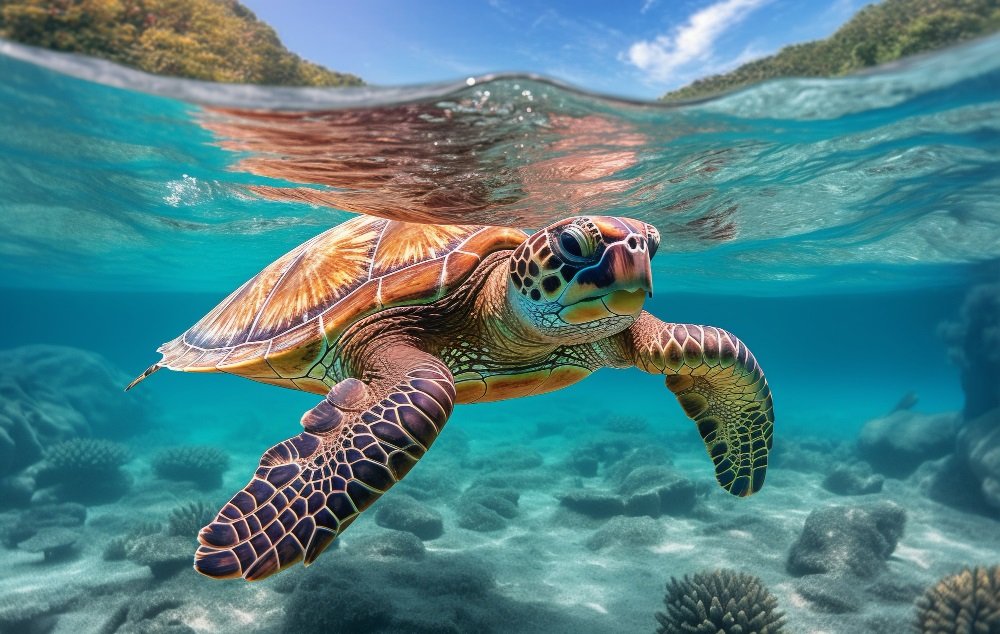Choosing the right habitat for your pet turtle is crucial for its health and well-being. Turtles have unique needs that differ significantly from fish, and simply tossing them into a fish tank can have detrimental consequences. Understanding the specific requirements of turtles and whether a fish tank can adequately meet them is essential for responsible pet ownership.
Can You Put Turtles in a Fish Tank?
The short answer is: it’s generally not recommended to keep turtles in a fish tank.
Why Not?
Here’s a breakdown of the key reasons why turtles and fish tanks are a poor combination:
- Space Requirements:
- Water Quality Issues:
- Temperature and Lighting Needs:
- Diet and Waste Management:
Can You Put Turtles In A Fish Tank?
Turtles and fish can seem like a natural pairing, both aquatic creatures sharing a love for water. However, the question of whether or not turtles can live in a fish tank is a complex one with a definitive answer: it depends. While it might seem like a simple solution to house both species together, there are several crucial factors to consider before making this decision.
Turtle Needs vs. Fish Needs
Turtles and fish have vastly different needs when it comes to their environment. Understanding these differences is essential for determining compatibility.
Habitat Requirements
- Turtles: Require a spacious tank with both land and water areas. They need ample room to bask, swim, and explore.
- Fish: Generally thrive in tanks with a focus on open water space, though some species prefer more complex setups with plants and hiding places.
Water Parameters
- Turtles: Tolerate a wider range of water temperatures and are more tolerant of fluctuations. They also produce more waste, requiring more frequent water changes.
- Fish: Often have specific temperature and pH requirements. Sensitive fish species can be negatively impacted by the waste produced by turtles.
Diet
- Turtles: Omnivores with a varied diet that includes insects, worms, fruits, vegetables, and sometimes small fish.
- Fish: Diets vary greatly depending on the species, but generally include flakes, pellets, and live or frozen foods.
Potential Problems with Mixing Turtles and Fish
While some fish and turtle species might seem compatible, there are several potential problems that can arise when keeping them together:
Predation
Many turtle species, especially smaller ones, are known to prey on fish. Even if the fish are larger than the turtle hatchlings, they may still be vulnerable to attack.
Competition for Resources
Turtles and fish can compete for food, basking spots, and even hiding places. This can lead to stress and health problems for both species. (See Also: What Kind Of Meat Do Turtles Eat)
Water Quality Issues
Turtles produce significantly more waste than fish, which can quickly degrade water quality. This can lead to ammonia and nitrite spikes, making the tank environment unsuitable for both turtles and fish.
Disease Transmission
Turtles and fish can carry different diseases that can be transmitted to each other. This can lead to outbreaks that can be difficult to treat.
When It Might Be Possible
While generally not recommended, there are a few scenarios where keeping turtles and fish together might be possible:
Large, Established Tanks with Specialized Filtration
A very large tank with a powerful filtration system might be able to accommodate both turtles and fish, but it would require meticulous maintenance to ensure water quality.
Non-Predatory Turtle Species and Compatible Fish
Some turtle species, like painted turtles, are less likely to prey on fish. Additionally, some fish species, like goldfish, are relatively hardy and can tolerate less-than-ideal water conditions. However, even in these cases, careful monitoring and management are essential.
Separate Basking Areas and Water Zones
Creating separate basking areas and water zones within the tank can help reduce competition for resources and minimize the risk of predation. (See Also: Can Turtles Eat Canned Tuna)
Alternatives to Mixing Turtles and Fish
The best way to ensure the health and well-being of both turtles and fish is to keep them in separate tanks. This allows you to provide each species with the specific environment and care they need.
Dedicated Turtle Tank
A turtle tank should be spacious enough to allow for swimming, basking, and exploration. It should also have a land area with a basking spot that is heated to a suitable temperature.
Dedicated Fish Tank
A fish tank should be appropriately sized for the species of fish you plan to keep. It should also have a good filtration system and regular water changes to maintain water quality.
Recap
While the idea of a shared aquatic habitat might seem appealing, the reality is that turtles and fish often have conflicting needs. Predation, competition, water quality issues, and disease transmission are just some of the potential problems that can arise when keeping them together.
The best option for both turtles and fish is to provide them with dedicated tanks that meet their specific requirements. This will ensure their health, happiness, and longevity.
Frequently Asked Questions about Turtles in Fish Tanks
Can turtles live in a fish tank?
It’s not generally recommended to keep turtles in a fish tank. While some small turtles might seem suitable, they have specific needs that are difficult to meet in a typical aquarium setup.
Why are fish tanks not suitable for turtles?
Turtles require a lot of space to swim and explore, as well as a basking area with a heat lamp. Fish tanks are often too small and lack the necessary features for a turtle’s well-being. (See Also: Can Turtles Eat Carrots)
What kind of habitat do turtles need?
Turtles need a large, spacious enclosure with both water and a dry basking area. They require a filter system to keep the water clean, a heat lamp for basking, and a UVB light for proper shell health.
Can turtles and fish coexist peacefully?
It’s not advisable to keep turtles and fish together. Turtles can be opportunistic feeders and may eat smaller fish. Additionally, turtles can stir up sediment in the tank, which can be harmful to fish.
What are some alternatives to a fish tank for turtles?
A larger aquarium, a specially designed turtle tank, or a pond are better options for housing turtles. These environments can provide the space and features they need to thrive.


